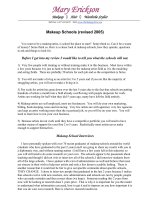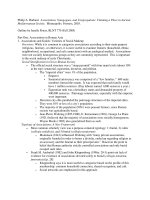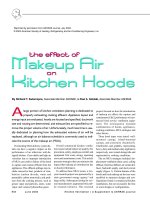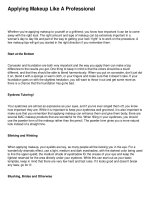Honors Physics Name: Unit IX (Electrostatics) Makeup Exam and Unit X ...
Bạn đang xem bản rút gọn của tài liệu. Xem và tải ngay bản đầy đủ của tài liệu tại đây (188.95 KB, 4 trang )
Honors Physics Name:
Unit IX (Electrostatics) Makeup Exam and Unit X (Circuits) Quiz Period:
1. Recall from chemistry that an ion is an electrically charged
atom, expressed by the notation X
N
where X is the chemical
symbol and N is an integer representing the number of
fundamental charges the atom has in excess (+) or in deficit (–).
For instance, an aluminum atom missing three electrons would
be represented as Al
3+
. A sulfur atom with two extra electrons
would be represented as S
2–
. The grid on the right depicts these
two ions situated in space.
a. Calculate the magnitude and direction of the net electric field
due to both the aluminum and sulfur ions at the point labeled ×.
Show your work neatly in the space below.
b. Draw in the electric field vector calculated in part (a) on the grid above. (What is important is that
you get the direction correct – you may make the arrow any length, within reason).
c. Calculate the magnitude and direction of the force exerted on a negatively charged fluorine ion (F
–
)
placed at point ×. (Hint: save time by using the relationship between field and force.)
Al
3+
S
2
–
×
Honors Physics Name:
Unit IX (Electrostatics) Makeup Exam and Unit X (Circuits) Quiz Period:
2. The diagram to the right depicts the +25 V,
0 V, –25 V, and –50 V equipotentials in
the region of three +1 nC charges and a
single –3 nC charge placed between them.
a. Label the equipotential lines with their
appropriate voltages. You’ll need to
make six labels, but some will have the
same value.
b. Consider the points a, b, c, and d.
i. At which of these four points is
the electric potential highest?
Circle one and explain below.
a b c d
ii. At which of these four points is the electric potential lowest? Circle one and explain.
a b c d
iii. At which of these points is the magnitude of the electric field highest? Circle one and explain.
a b c d
c. On the diagram above, draw in your best approximation of the –12.5 V equipotential.
d. Calculate the electric potential at point d above. Express your answer with appropriate units.
Make sure your answer is consistent with the equipotential values given in the problem.
e. Qualitatively sketch in electric
field lines (with appropriate arrow
heads) on the diagram at left.
Let six field lines leave each of the
positive charges.
d c b
a
Honors Physics Name:
Unit IX (Electrostatics) Makeup Exam and Unit X (Circuits) Quiz Period:
3. Imagine moving a positively charged dust grain around in a region of space filled with a varying
electric potential. The grain has an electric charge of 5.5 μC (5.5 ×10
−6
C) and a mass of 8 milligrams
(8×10
−6
kg).
a. Does the grain have more electric potential energy when it is at a high potential (1000 V)
or at a low potential (200 V)? Explain.
b. Would your answer to part (a) change if the dust grain were negatively charged instead?
Explain.
c. How much energy do I have to expend (in the form of work) to move the positively
charged dust grain from an electric potential of 200 V to an electric potential of 1000 V?
d. If I then release the grain at 1000 V, so that it travels back “down” to 200 V, how fast is it
going when it reaches 200 V?
You may skip the next problem with no penalty. However, if you have time, work this problem to
demonstrate mastery.
4. The typical distance between the electron and proton in a hydrogen atom is 5×10
11
m. Use this fact
and any fundamental constants you need from your equation sheet to determine the typical speed of
an electron in a hydrogen atom. (Hint: assume the electron is moving in a circle, and that the
centripetal force is just electrical attraction. You may neglect gravity.)
Honors Physics Name:
Unit IX (Electrostatics) Makeup Exam and Unit X (Circuits) Quiz Period:
5. Complete the following sentence. (This is an openended question.)
Ultimately, the purpose of a circuit is to…
6. Correct the following false statement made by a student struggling to understand electrical circuits.
Your response should identify the flaw(s) and offer a correct and thorough response
“The charge becomes used up as it passes through the light bulb”
7. A circuit contains a battery, wires and a light bulb. Which of the following would cause the bulb to
shine more brightly? Circle all that apply.
a. increase the voltage of the battery
b. decrease the voltage of the battery
c. decrease the resistance of the circuit
d. increase the resistance of the circuit
8. Approximately how much power is dissipated through a hair dryer with a resistance of 15 Ω?
Assume it is plugged into a standard US household outlet at 120 V.
9. Consider the circuits below.
a. Calculate the equivalent resistance (total resistance), R
tot
, for this circuit:
b. Fill in the table above with your predictions for the current and voltage readings you expect.
Don’t forget to include units. Show your work in the space below.
CIRCUIT
ammeter 1 ammeter 2 voltmeter
30 V
15 Ω
ammeter 1
voltmeter
ammeter 2
10 Ω
°
°









